Adapting a Design Sprint for Carbon Direct's Product Roadmap

At-a-Glance
Shortly after joining Carbon Direct, I leveraged my skills and experience to craft and facilitate a cross-functional collaborative effort aiming to rapidly define the potential product roadmap of the "Decarbonization" workstream. Despite challenges including a newly formed team, limited domain knowledge, lack of leadership direction, and limited insights into users' decarbonization needs, I identified an opportunity to adapt a Design Sprint to overcome these obstacles and generate praised levels of collaboration and team building.
Within a week, I led our team to establish clear market positioning, identify customer journeys, define ideal customer targets, engage subject matter experts, generate informed sketches, and deliver a comprehensive flowchart and wireframes to guide the product roadmap. Beyond delivering a roadmap, this project reinforced collaboration between carbon scientists and the wider product team, fostering a more collaborative and inclusive environment while promoting the value of design across the organization.
Role
Sr. Product Designer — UX Research, Workshop Faciliation, Visual Design, User Flows, Rapid Prototyping
Team
Laura, Sr. Product Manager
Jasper, Sr. Engineer
Myself, Sr. Product Designer
Timeline
One week
Tools
Miro, Zoom, Google Drive, A lot of communication
Introduction
As I joined Carbon Direct, I was immediately presented with an exciting challenge that would test my skills as a Senior Product Designer. Carbon Direct, a company known for its robust, science-backed solutions, helps businesses and governments measure and manage their carbon footprint through advisory services and a SaaS platform. Serving a diverse customer portfolio, including Fortune 500 companies, high-growth startups, and primary sector industries, Carbon Direct offers comprehensive solutions that allow customers to manage their carbon footprint across three key areas: measurement (GHG inventory), reduction (decarbonization strategies), and removal (carbon credit voluntary market).
While well-established in the measurement and removal spaces, the "Decarbonization" area, focusing on reduction and mitigation strategies, represented a new opportunity for Carbon Direct to expand its offerings and impact. I was thrilled to be tasked with joining the newly formed Decarbonization team and establishing the scope and roadmap for this workstream. Our starting point was a common customer question:
I collaborated closely with Laura (Sr. Product Manager) and Jasper (Sr. Engineer) as the core team. To ensure we leveraged all available expertise, I also involved cross-functional stakeholders in collaborative workshops, including a Climate Scientist, Customer Support Manager, Carbon Accountant, and Data Analyst.
I structured the project to run for 5 days, with the following key milestones:
- Collect existing insights about customers and the market
- Identify past decarbonization efforts and pain points
- Focus the scope and prioritize a user problem to solve
- Run collaborative sessions to validate assumptions, test ideas, and generate sketches
- Develop a user flow and wireframes representing potential solutions
- Present results to leadership
Challenges
As I dove into the project, I quickly realized our team faced several significant challenges:
These challenges reflected Carbon Direct's broader aim of productizing deep scientific expertise and bespoke advisory solutions into a scalable SaaS platform. I was excited by the opportunity to showcase how we could achieve this while identifying the ideal customer profile for maximum impact.
Approach and Methodology
To rapidly align the team and leverage internal expertise under tight timelines, I adapted the Design Sprint to focus on the Understand, Sketch, and Decide phases. I was confident that tailoring the Design Sprint would allow us to:
- Gather existing customer insights and identify past decarbonization efforts
- Accelerate the team's learning curve by engaging carbon science experts
- Make rapid decisions to move forward despite uncertainty
- Focus on translating domain expertise into compelling platform features
I facilitated collaborative Miro workshops to map the problem space, sketch solutions, and define a roadmap. Additionally, I conducted individual interviews with cross-functional stakeholders to gather insights and validate assumptions.
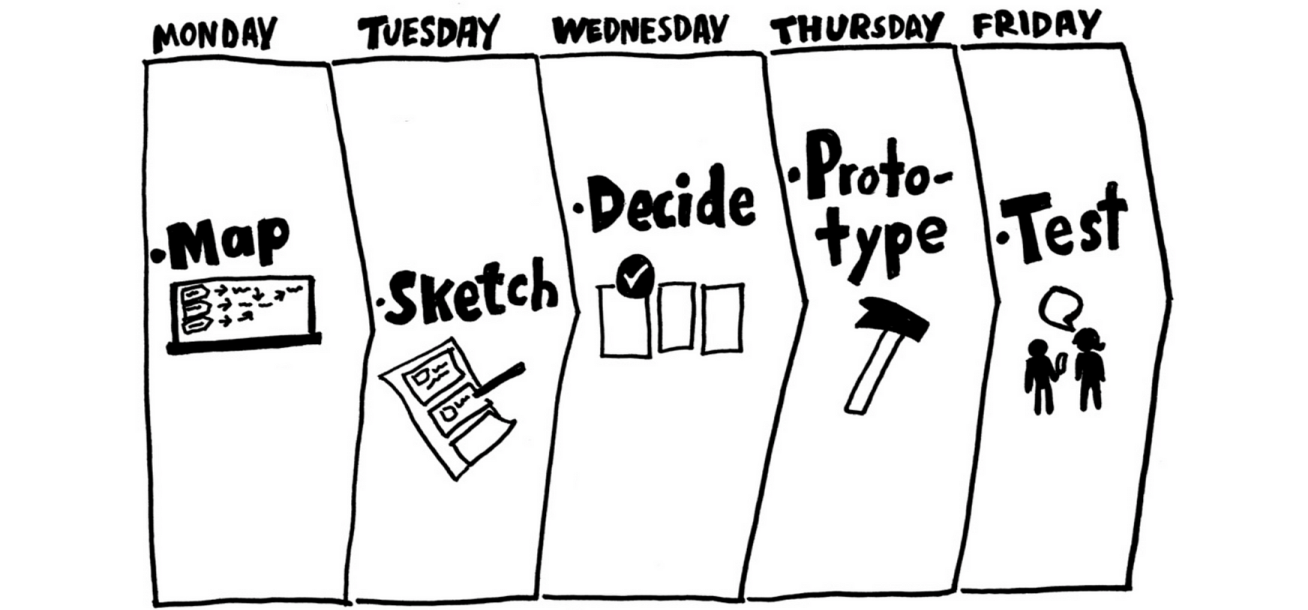
Process & Execution
Each day of the sprint, our process centered around key activities:
Insight Collection and Problem Definition
Problem Mapping and Goal Setting
Expert Consultation and Problem Targeting
Solution Ideation
Concept Refinement and Presentation
Deliverables and Artifacts
Throughout the sprint, we created several key deliverables that guided our thinking and decision-making:
Market Positioning and OKR Alignment.
I spearheaded the effort to define Carbon Direct's market positioning for its decarbonization solution. This involved a thorough analysis of our unique value proposition and how it fits within the broader market landscape. I ensured that this positioning aligned with our company's objectives and key results (OKRs), creating a clear link between our product strategy and overall business goals.
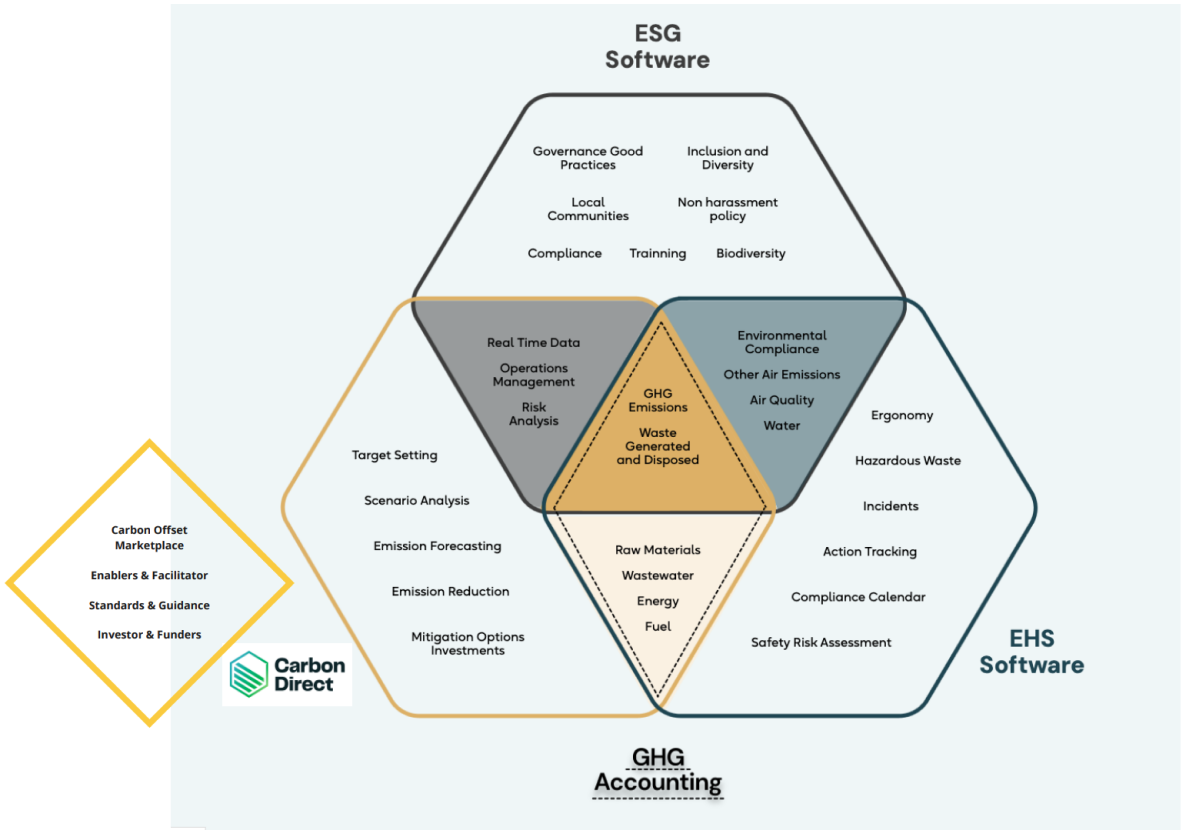
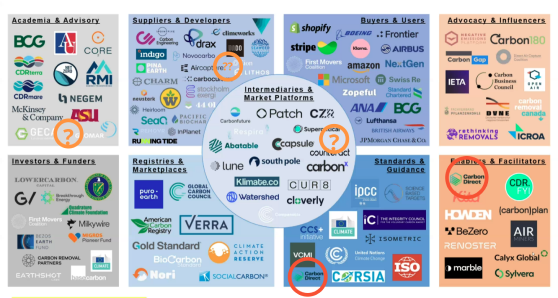

User Journey Maps.
I facilitated the creation of comprehensive user journey maps that captured the entire customer experience across the carbon management process. These maps placed special emphasis on the critical decarbonization phase. Through multiple iterations and collaborative sessions with the team, we refined these maps based on insights about varying customer "carbon maturity" levels, providing a nuanced view of user needs at different stages of their decarbonization journey.
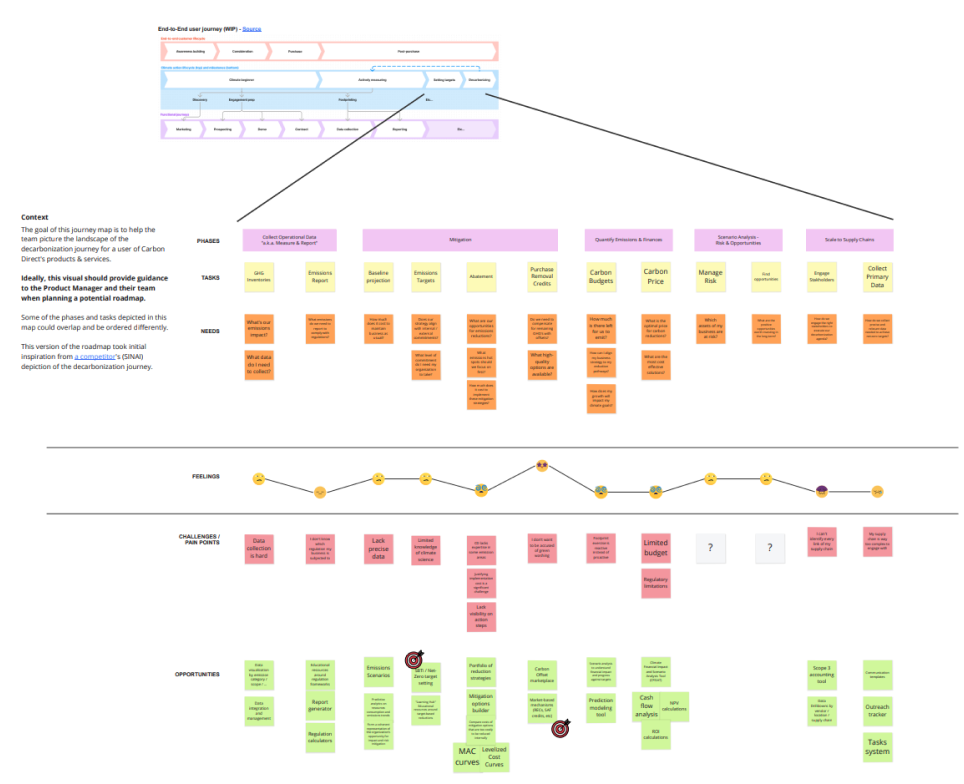


Persona Cards.
Building on our research and analysis, I guided the team in developing detailed persona cards representing our ideal platform customers. I was thrilled to uncover the concept of "carbon maturity" levels, which emerged as a key lens for prioritizing features and solutions. Each persona card included rich details about user goals, pain points, and needs, serving as a valuable reference point throughout our design process.
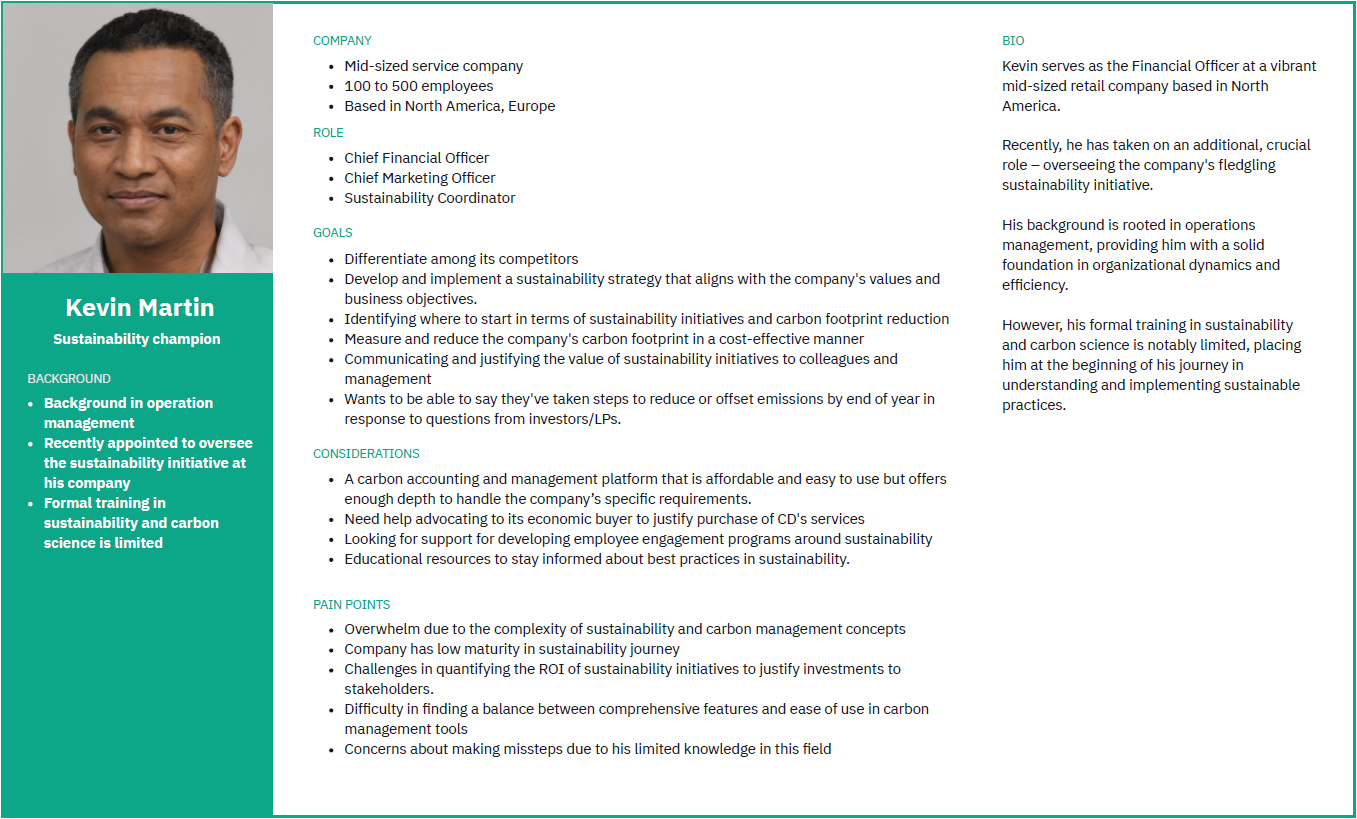
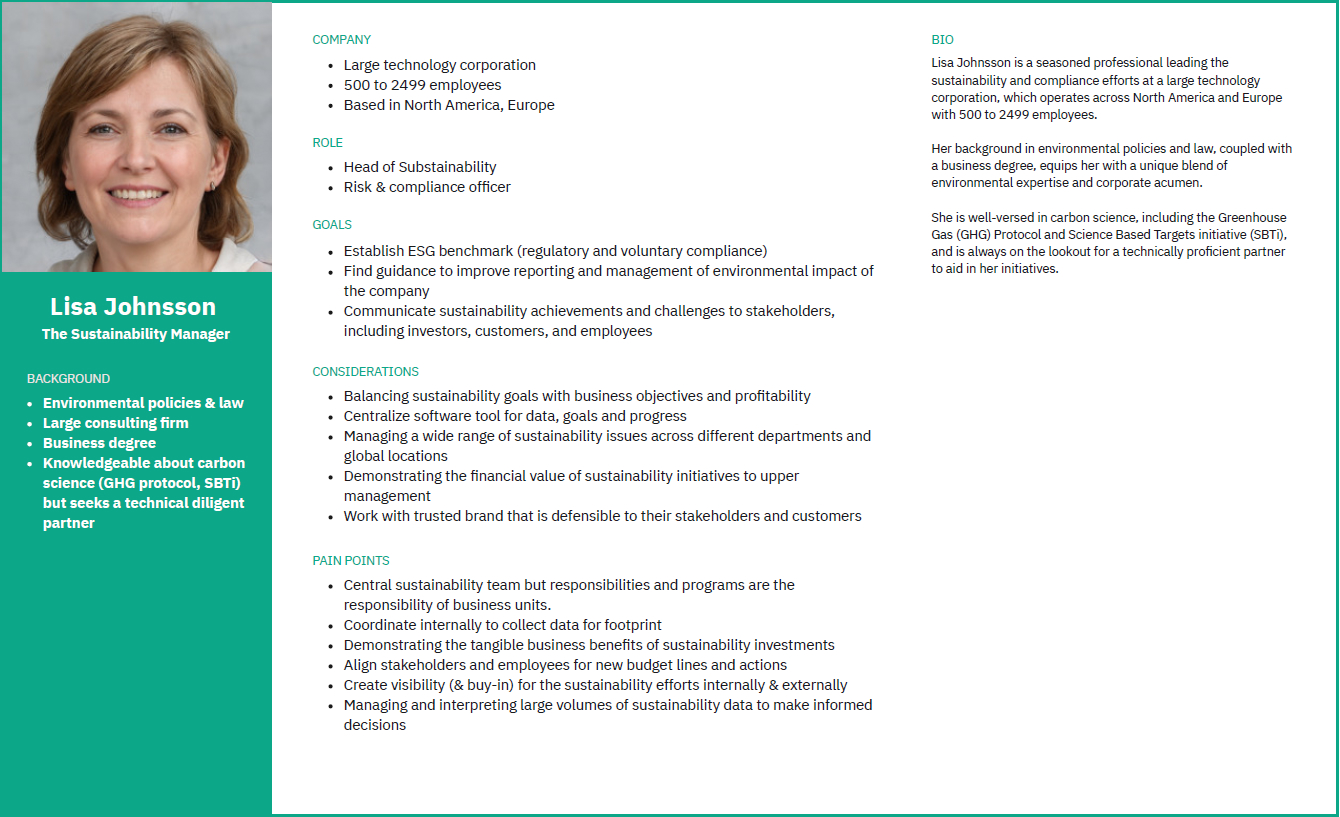

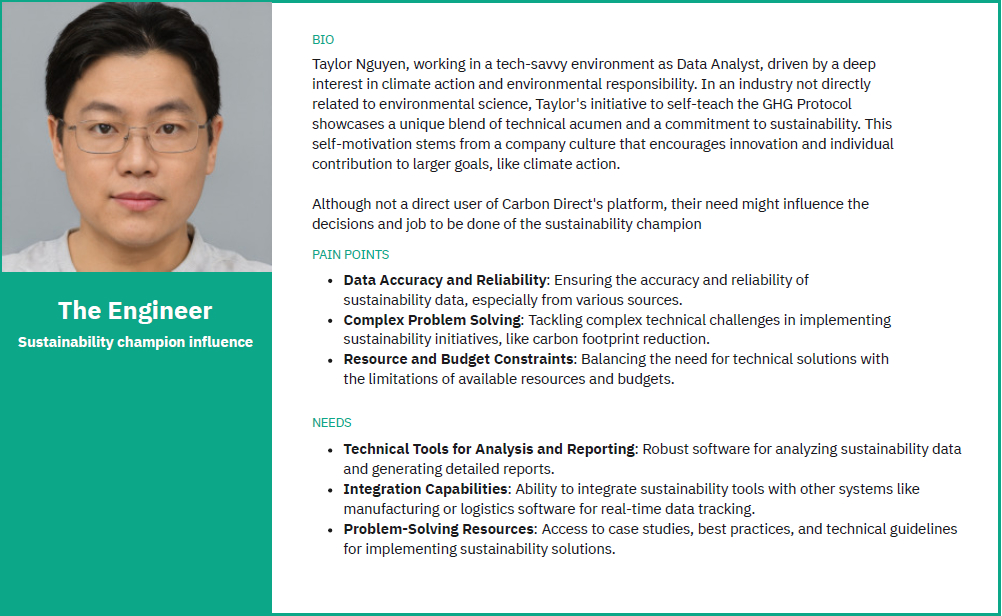
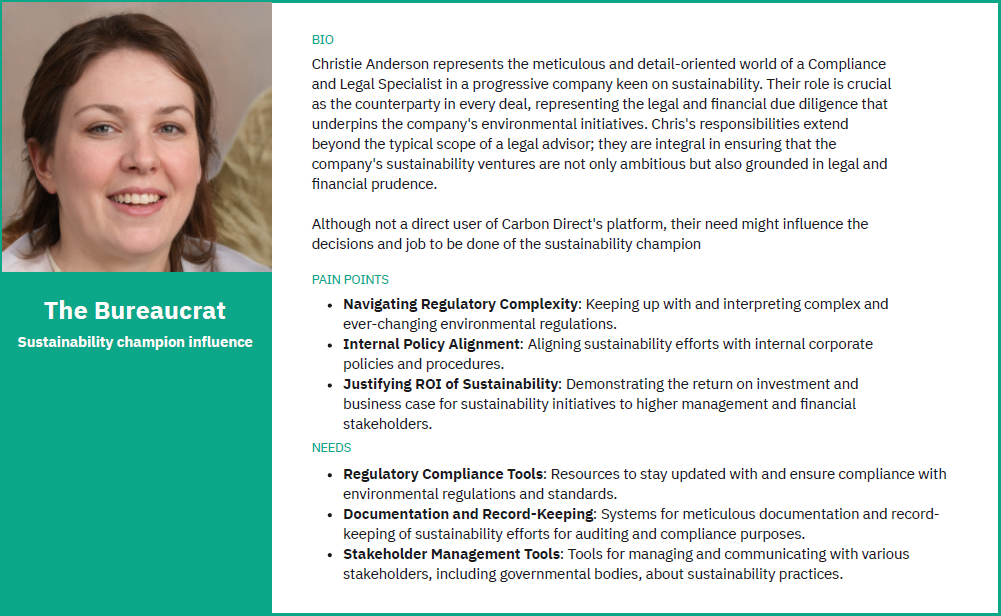
Science Advisor Role Documentation.
I took the initiative to interview members of our science advisory team, gaining deep insights into their unique tasks, challenges, and needs when working with customers on decarbonization strategies. This documentation ensured that our solutions were firmly grounded in the realities faced by our internal experts, bridging the gap between scientific expertise and user-friendly platform design.
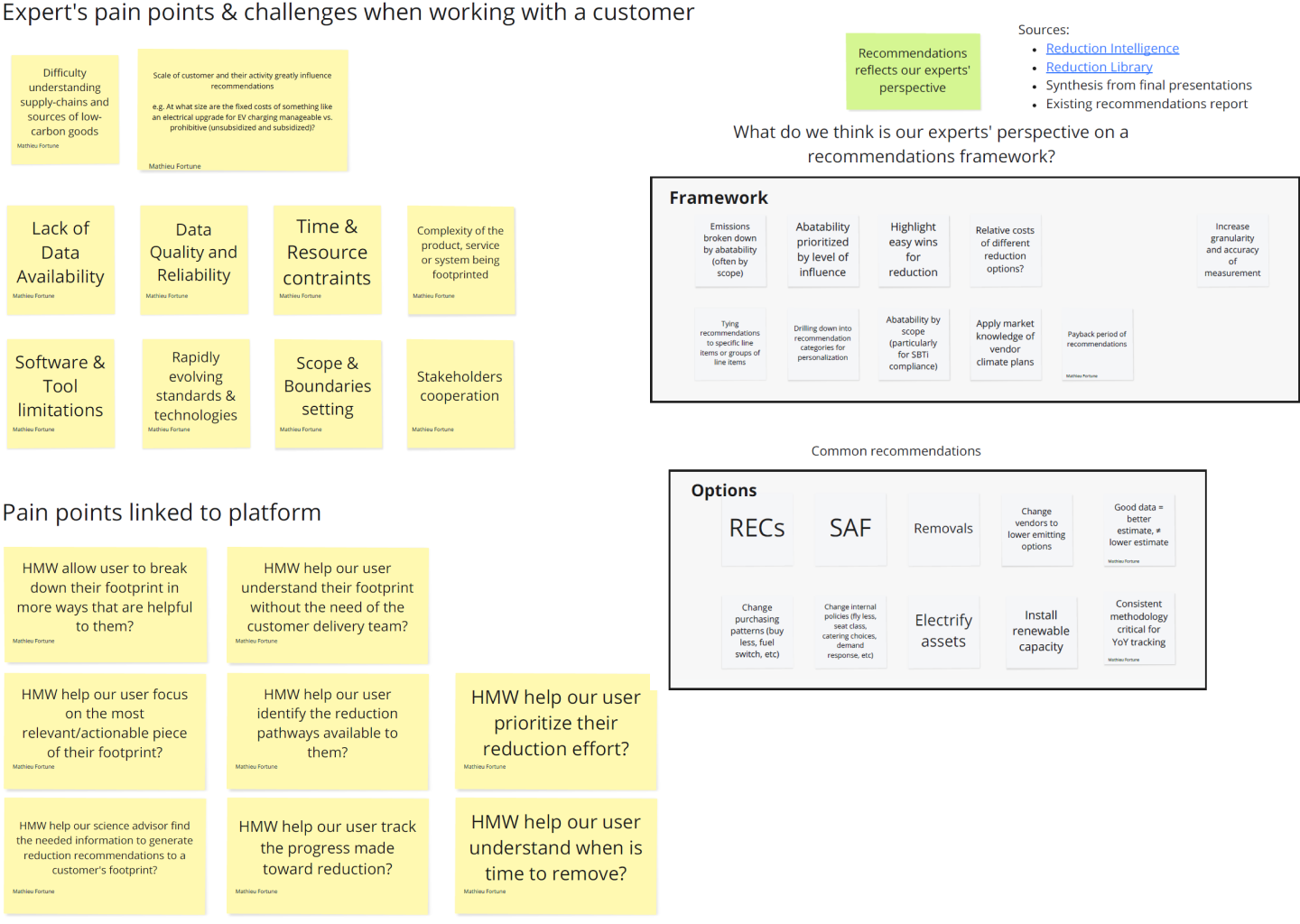
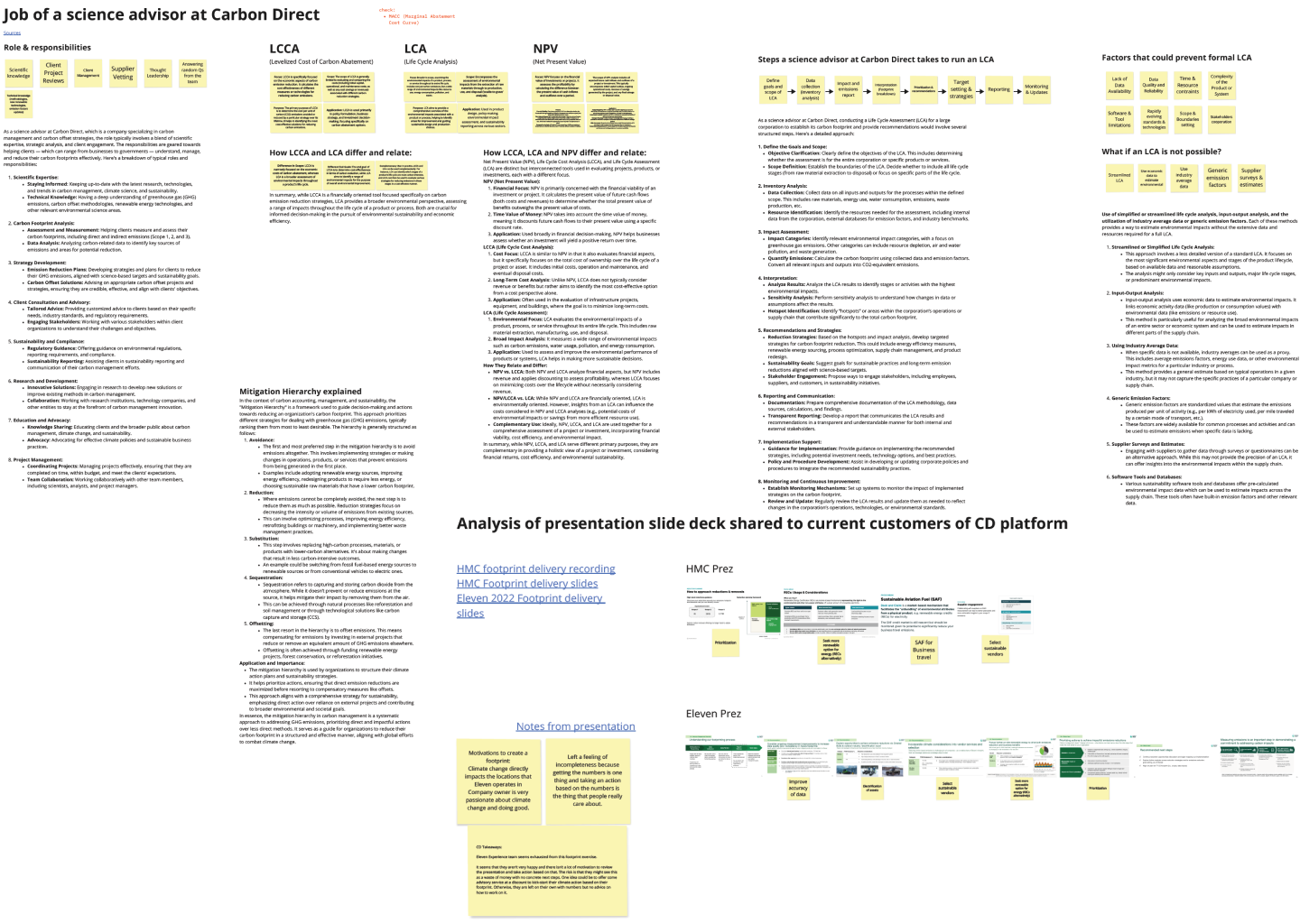
Problem Map and "HMW" Statements
I facilitated the creation of a comprehensive map representing key actors in the decarbonization workstream. This map served as a foundation for gathering feedback from our cross-functional team. I then led the effort to distill this feedback into actionable "How Might We" (HMW) statements. These statements captured both user and internal team pain points and needs, providing clear direction for our ideation process.
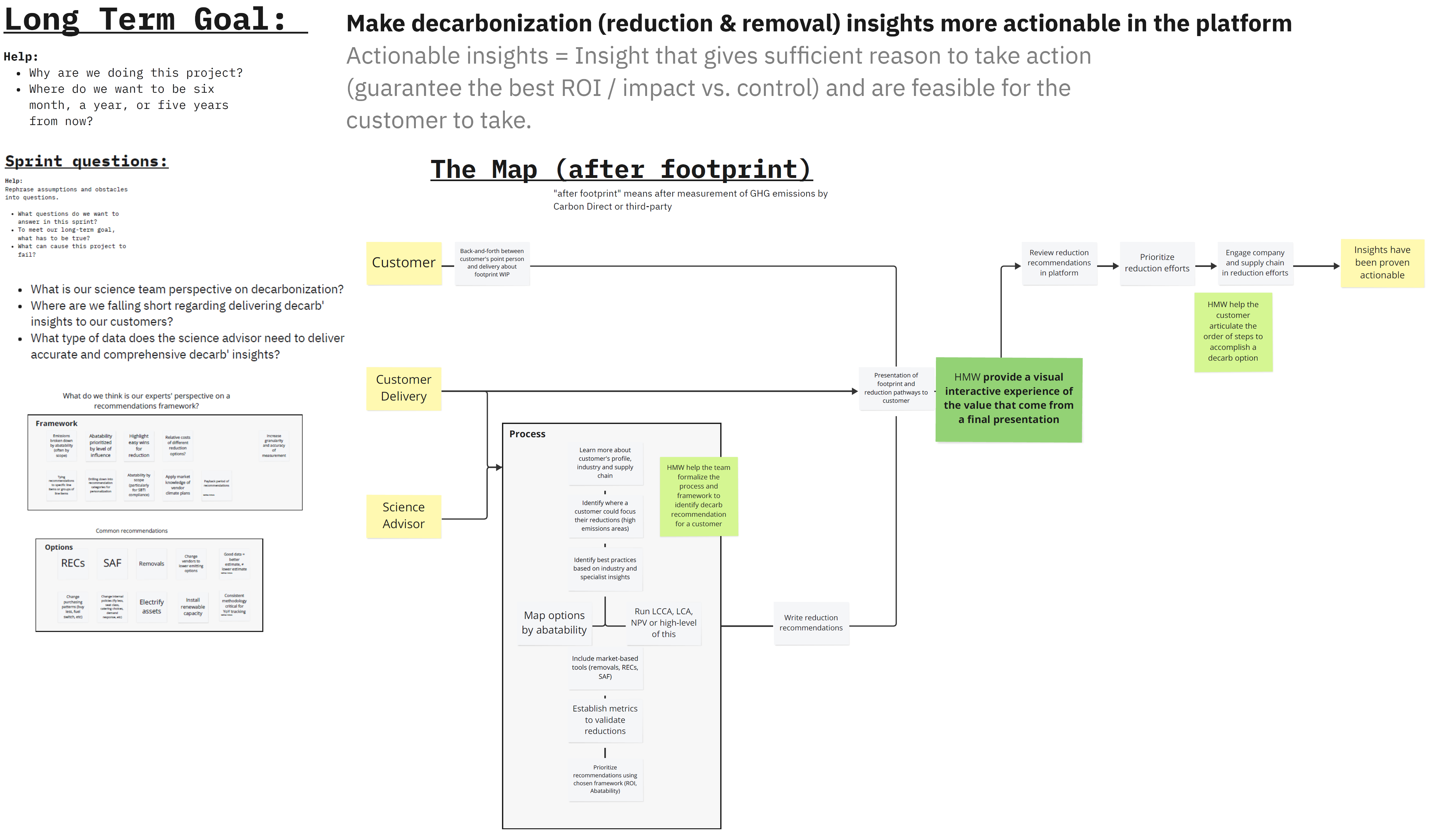
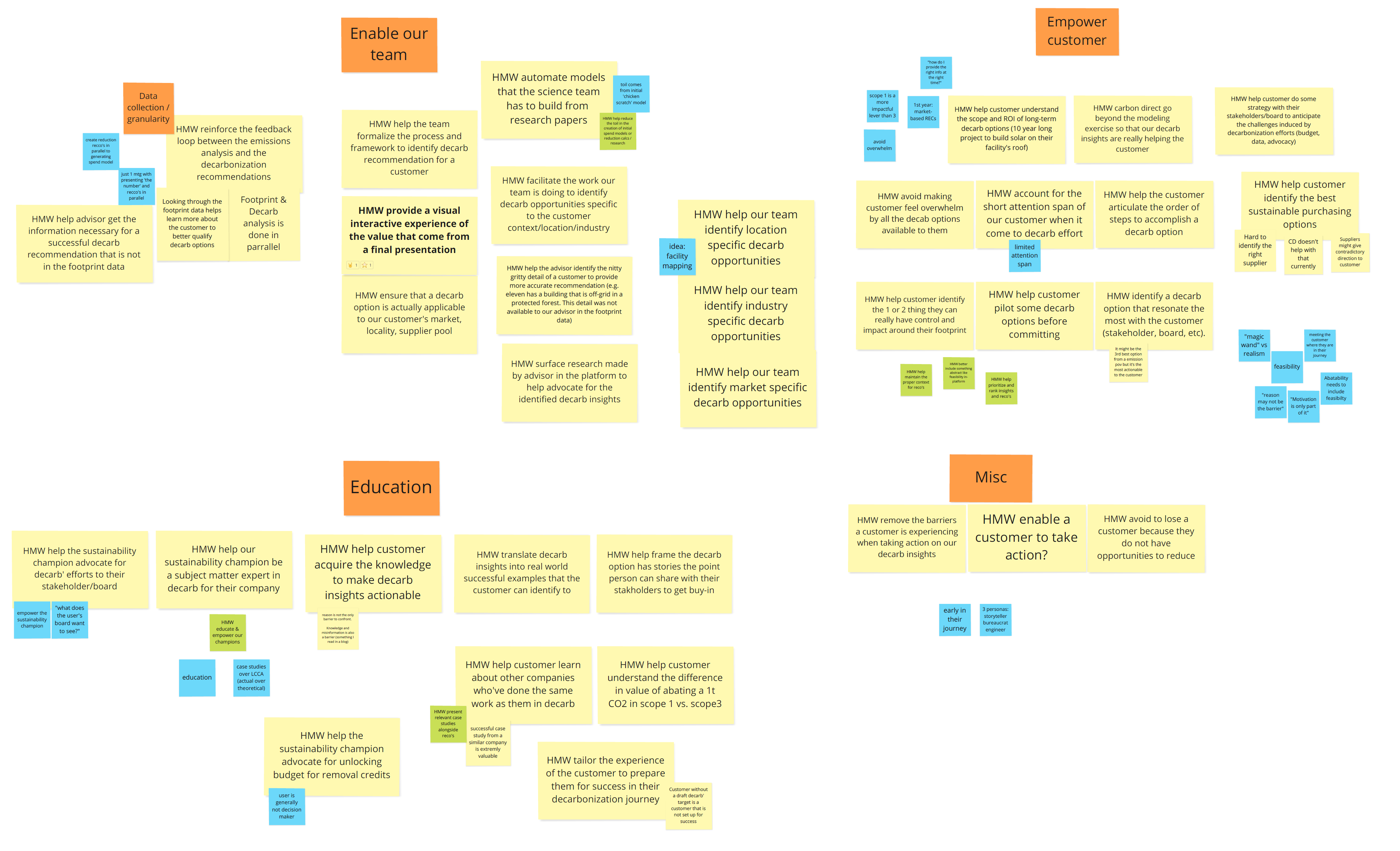
Solution Sketches.
Using our HMW statements as prompts, I organized and facilitated a dynamic sketching session. This collaborative effort ensured our team generated a wide range of potential solutions directly addressing the identified challenges. I was impressed by the creativity and insights that emerged during this session, resulting in sketches that served as a visual brainstorm, capturing innovative ideas and potential feature concepts.
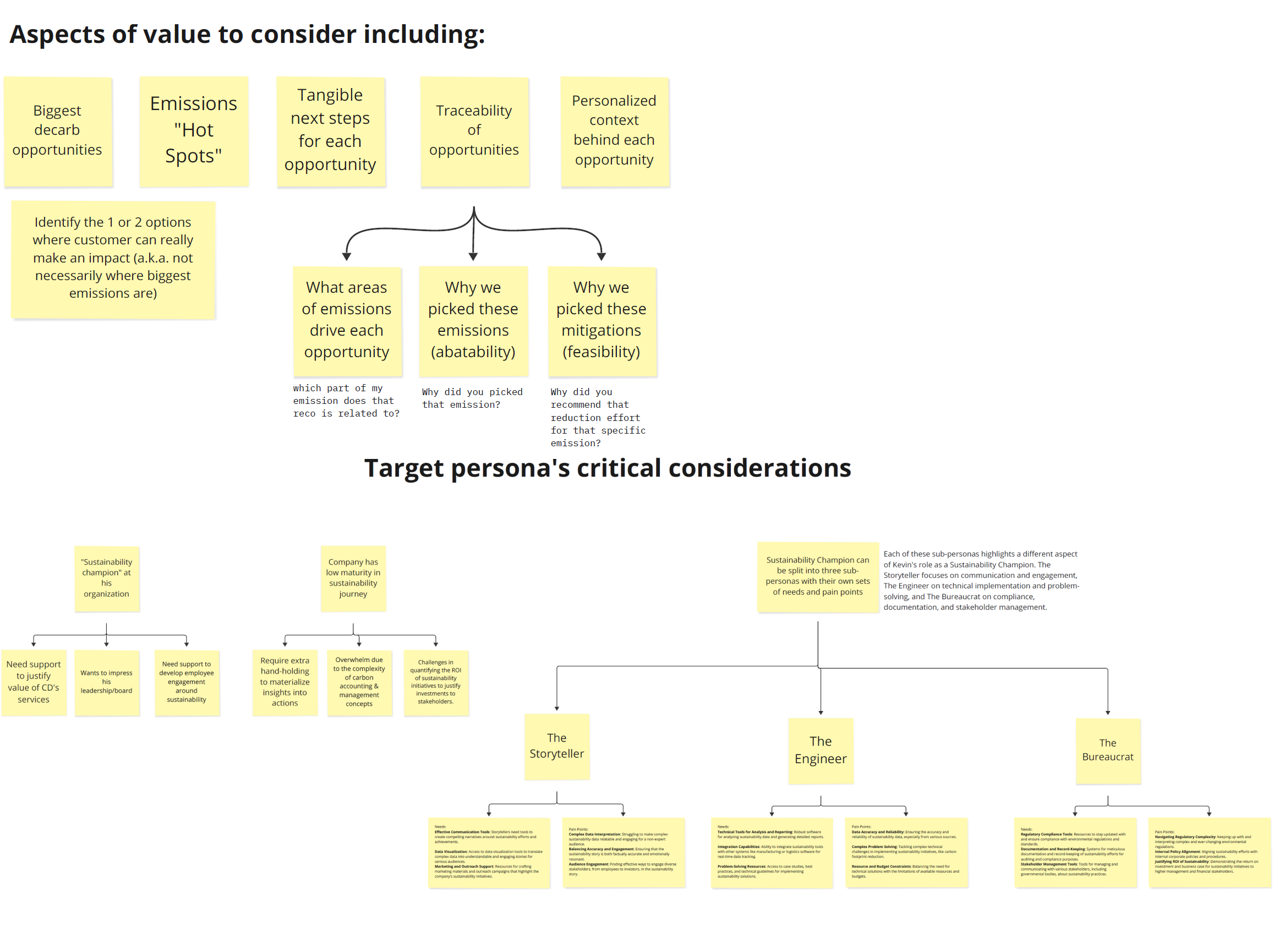
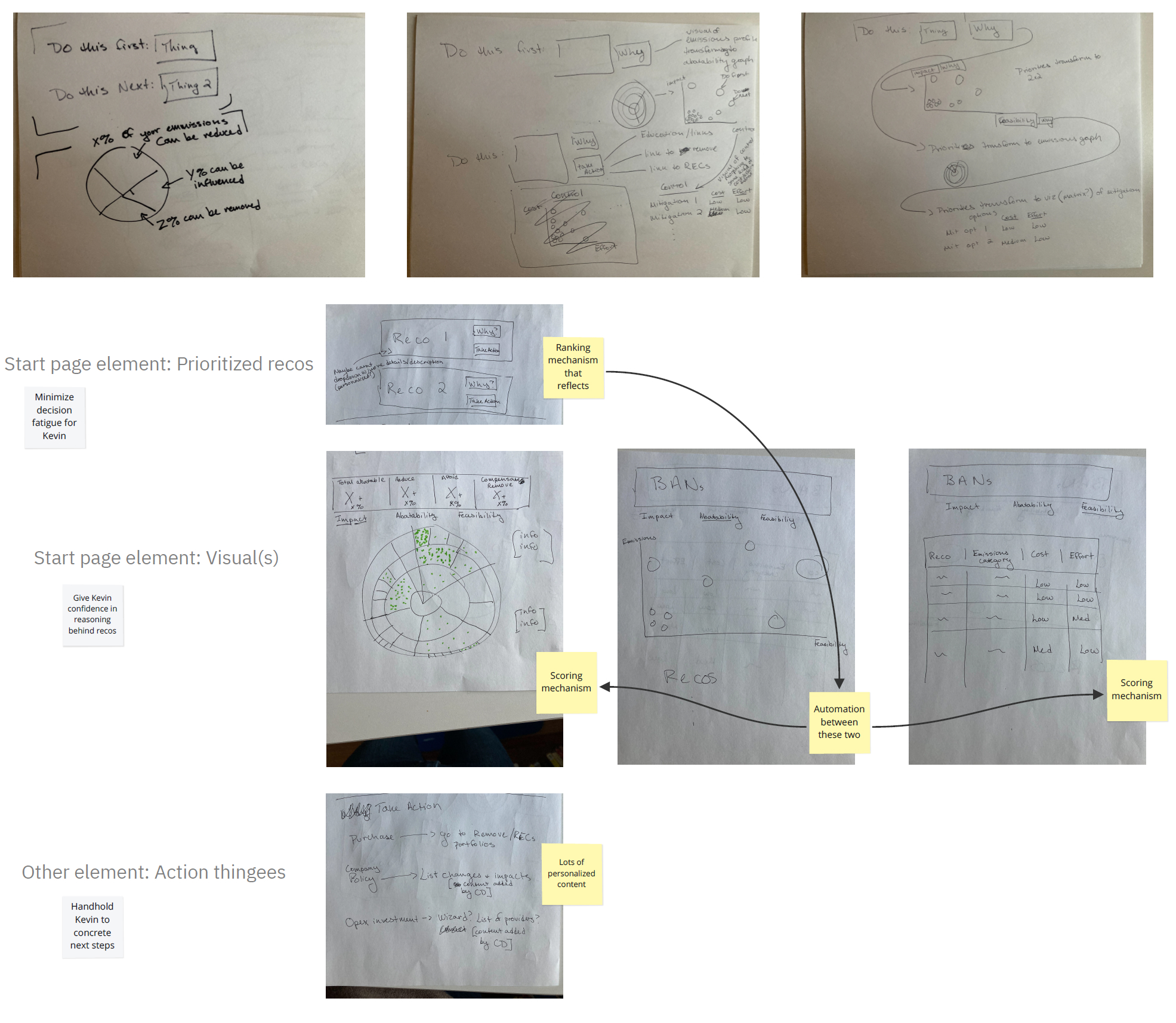
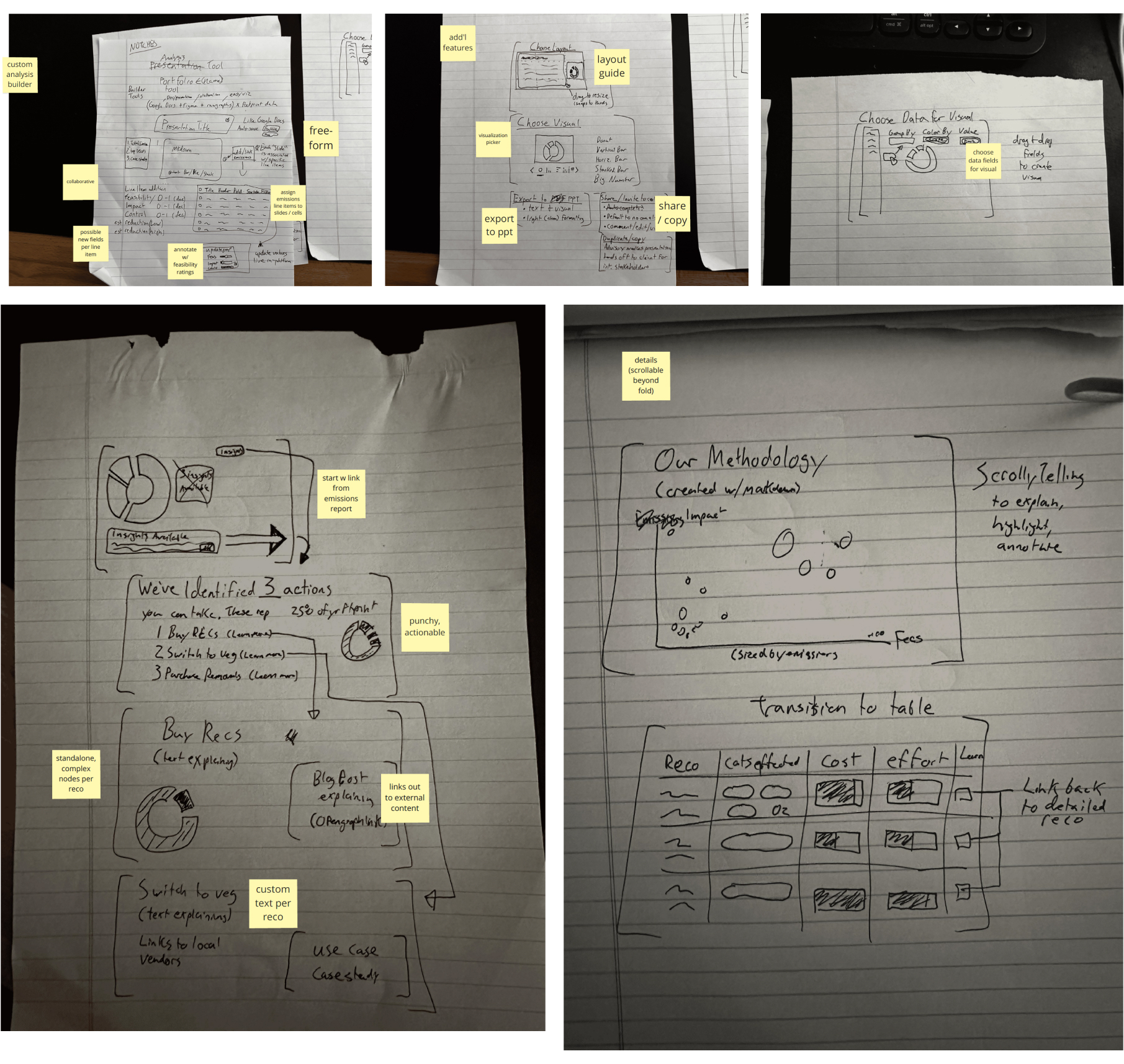
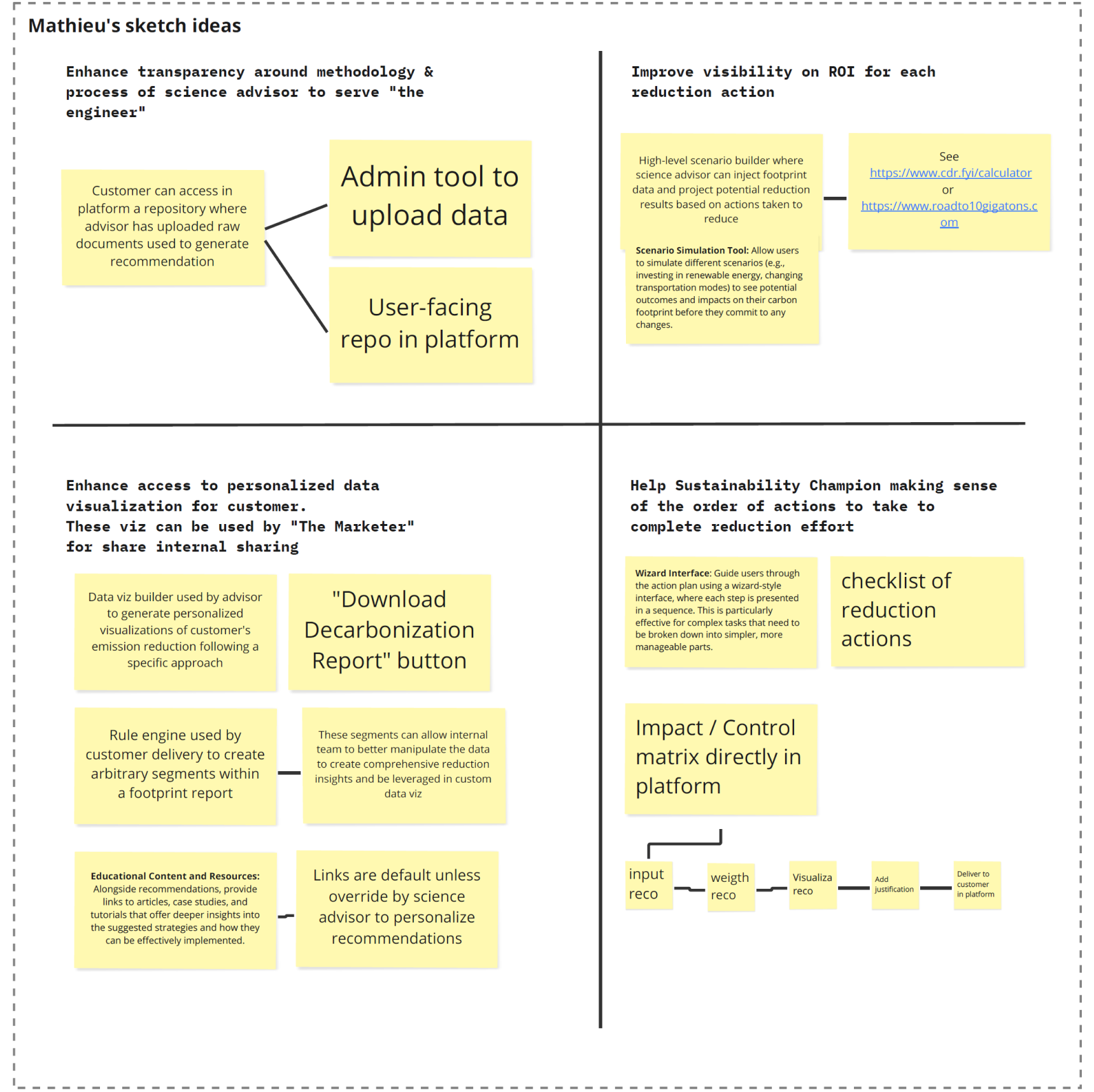
Flowchart Diagram and Roadmap.
Synthesizing insights from all previous sprint stages, I developed a comprehensive flowchart diagram that formed the backbone of our 6-month decarbonization roadmap. This flowchart connected our proposed solutions into a coherent, actionable plan, illustrating how different features and touchpoints would work together to address user needs and business objectives.

Wireframes.
To effectively communicate our ideas and proposed solutions to stakeholders, I created detailed wireframes. These wireframes brought our key concepts to life, showcasing the potential user interface and interactions. They served as a powerful tool for facilitating discussions around feasibility, impact, and next steps in the development process.
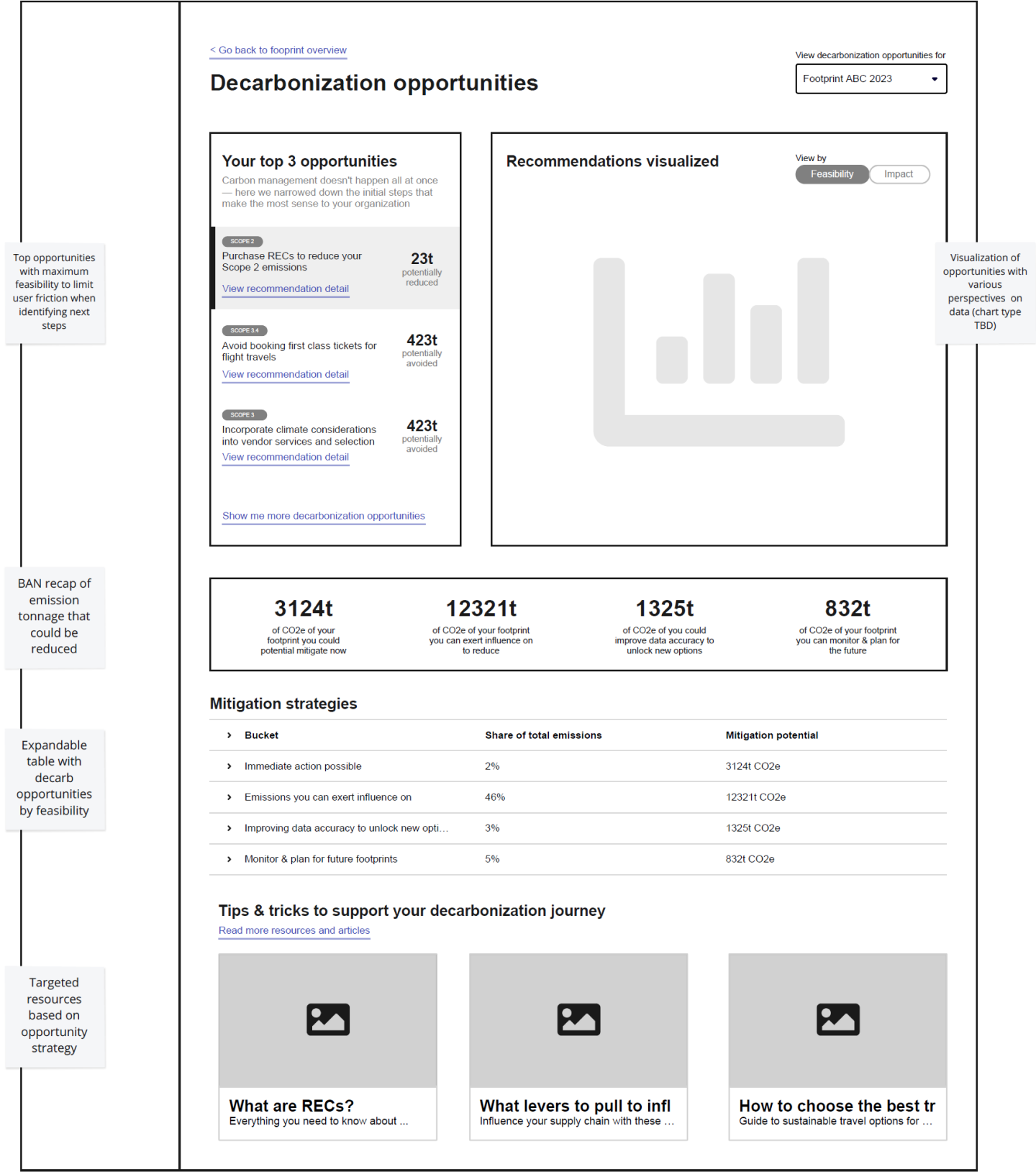
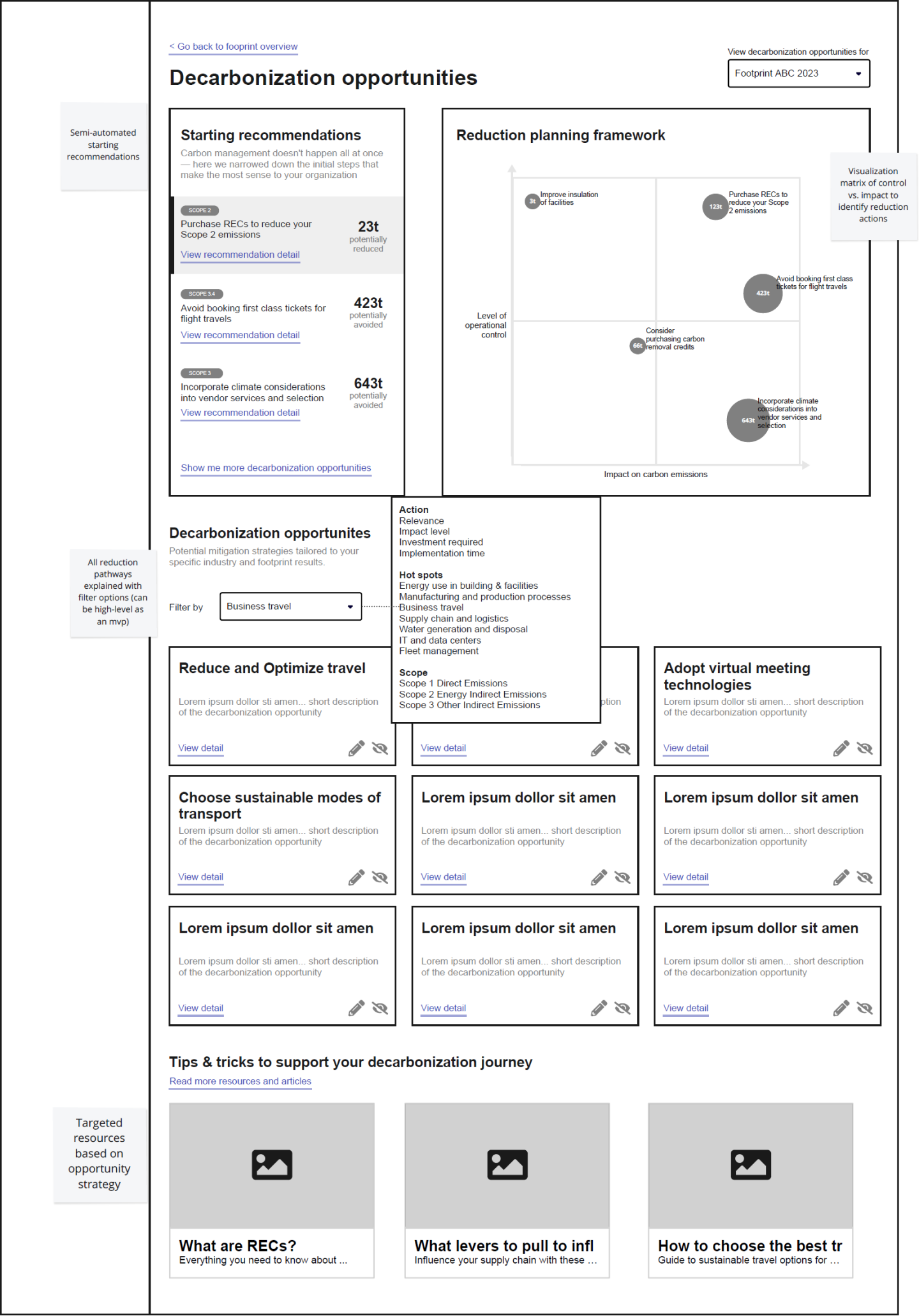
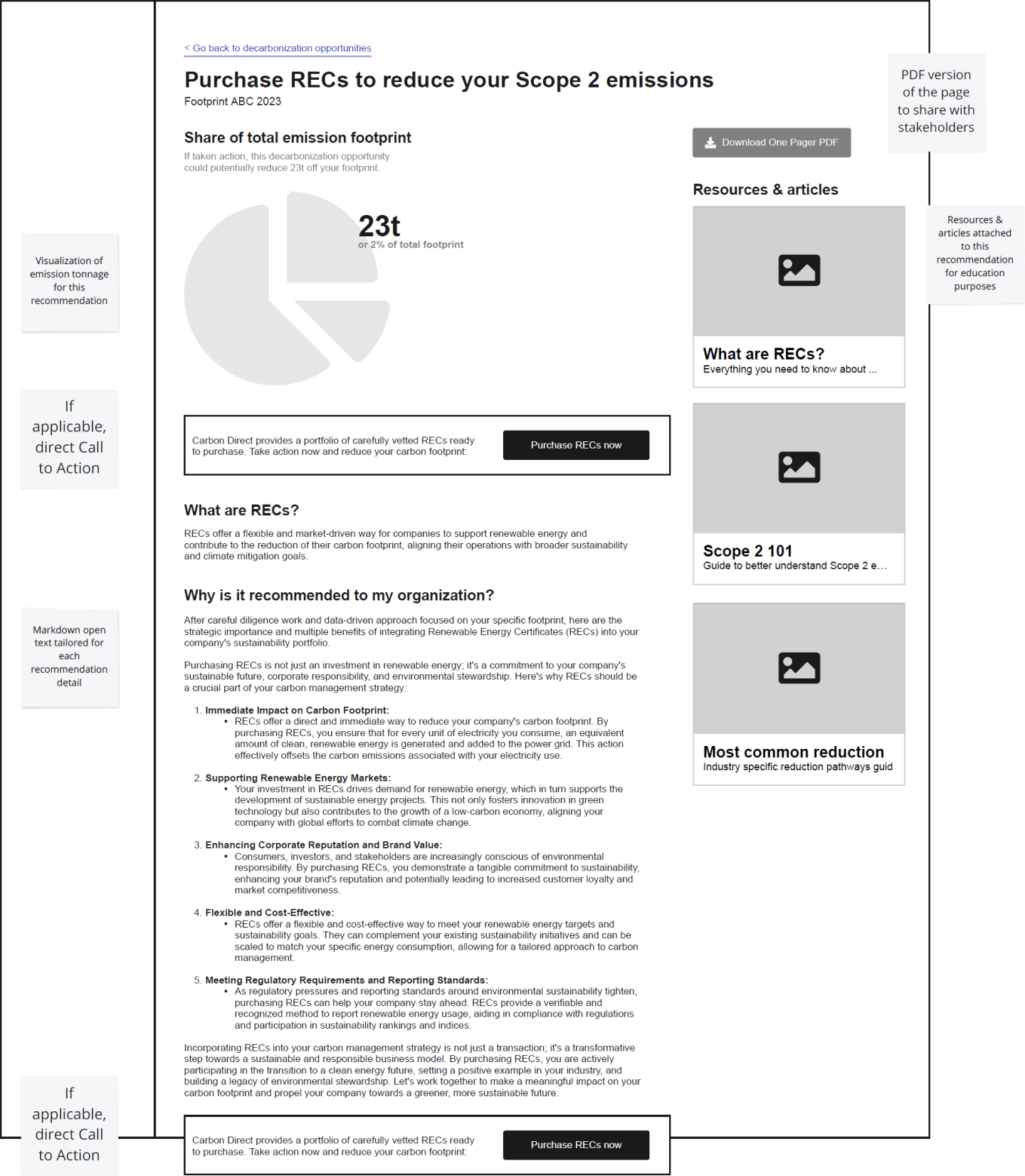
Challenges encountered during the sprint
As a senior product designer facilitating this design sprint, I encountered and overcame several challenges. Two significant hurdles we faced were managing scope and focus, and maximizing limited stakeholder availability:
Managing Scope and Focus
The challenge: After our first day of the sprint, the breadth of gaps and opportunities we had identified was overwhelming. It became clear we couldn't address all these points within the constraints of our sprint, potentially derailing our progress.
My approach:
- I quickly brought the issue to the team's attention, facilitating an open discussion about the various opportunities and their potential impact.
- Together, we made the difficult but necessary decision to draw a line in the sand and move forward with a specific long-term goal.
- I ensured we thoroughly documented our decision-making process, anticipating the need to justify our choice later.
- We created a backlog of the other identified opportunities, preserving these valuable insights for future exploration.
The outcome: This decision-making process allowed us to move forward with a clear focus while keeping track of future areas to explore. We chose a goal that we believed would best synergize with our customer needs and business objectives. By addressing this challenge head-on, we maintained momentum and delivered more impactful results by the end of the week, while also demonstrating our strategic thinking to stakeholders.
Maximizing Limited Stakeholder Availability
The challenge: Ensuring efficient use of our science advisors' limited time during the sprint was crucial. These key stakeholders had numerous responsibilities, and their availability was constrained.
My approach:
- I conducted preliminary research to understand the science advisors' roles and responsibilities.
- This groundwork allowed my team to formulate informed assumptions about their work processes and pain points.
- I established a clear schedule and structure for each interview, preparing targeted questions and scenarios based on our assumptions.
- During the interviews, we focused on quickly validating or challenging these assumptions, rather than engaging in open-ended discussions.
The outcome: This strategic approach allowed us to gather maximum insights in minimum time, respecting our stakeholders' busy schedules while still obtaining crucial information. By thoroughly preparing and structuring our interactions, we made the most of the limited time available, ensuring that every minute with our science advisors contributed valuable insights to our sprint outcomes. This experience underscored the importance of preparation and strategic thinking in design sprints, especially when working with stakeholders who have significant time constraints.
Outcomes and Impact
It was rewarding to see that our project received praise from peers and leadership for rapidly aligning the team and generating meaningful solutions. The "Carbon maturity" concept we developed was further iterated upon and integrated into the company's strategic thinking. One of the most rewarding outcomes was seeing how the project improved collaboration between advisory and platform teams and provided leadership with insights into the challenges and opportunities of productizing bespoke solutions.
“Hats off to Mathieu for diving in and helping us define our team’s roadmap after just a few weeks at the company. Despite being new to the domain and facing a complex problem, Mathieu’s proactive approach and eagerness to learn were crucial to the success of our ideation sessions.”
“Mathieu’s expertise really shone through during the design sprint. It was not only a chance for us to create a solid roadmap but also to build strong connections within our newly formed team and with cross-functional colleagues. I’m excited to be working with you, Mathieu!”
“Big shoutout to the decarb team for leading an impactful ideation session under a tight timeline and tackling such complex challenges. I’ve heard great feedback from both the science and customer support teams about this work. Well done!”
While the Decarbonization team unfortunately dissolved shortly after the design sprint due to the Product Manager's departure, the impact of our work continued to resonate. I was reassigned to the "Measure" workstream, where I applied the insights and methodologies from this sprint to drive significant results over the next seven months:
in newly signed contractul value,
with my design efforts directly correlating to renewals and new customer contracts.
saved annually for internal team,
resulting in a 15% efficiency gain linked to my design efforts.
Lessons
This experience reaffirmed my belief that Design Sprints are a powerful tool for focusing a team and generating meaningful solutions, even within tight constraints. However, I learned that a tool like Design Sprint is only effective when tailored to the unique needs of its participants. Drawing on my years of experience with various design processes, I was able to quickly adapt this approach to fit our specific circumstances.
“Tools like Design Sprint are only effective when tailored to the unique needs of its participants
“Cross-functional collaboration is key to success of large and complex initiatives”
This experience also helped me further hone my ability to effectively communicate how this process could streamline our work and deliver impactful results. Leveraging my background as a design consultant and founder, I was able to speak the language of my cross-functional colleagues, aligning our efforts and ensuring successful collaboration.